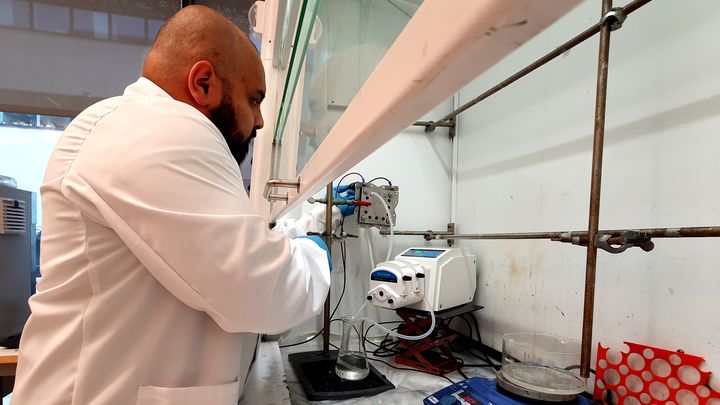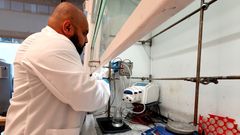New hydrogen producing method is simpler and safer
Researchers in Sweden unveiled a new concept for producing hydrogen energy more efficiently, splitting water into oxygen and hydrogen without the dangerous risk of mixing the two gases.

Developed at KTH Royal Institute of Technology in Stockholm, the new method decouples the standard electrolysis process for producing hydrogen gas, which splits water molecules by applying an electric current. In contrast with prevailing systems the resulting oxygen and hydrogen gases are produced separately rather than simultaneously in the same cell, where they need to be separated by membrane barriers.
That separation eliminates the possibility of the gases mixing, and thus the risk of explosions, says researcher Esteban Toledo, a PhD student at KTH who co-authored the paper published today in Science Advances along with Joydeep Dutta, professor of applied physics at KTH. It also eliminates the need for rare Earth metals.
The two researchers patented the system and a company, Caplyzer AB, was formed through KTH Innovation to scale the technology.
Dutta says the hydrogen gas Faradaic efficiency was shown to be 99 percent. The researchers also report that lab tests showed no apparent electrode degradation as a result of long-term tests, which is important for commercial applications.
Producing hydrogen from water always generates oxygen. A typical alkaline electrolyzer has a positive and negative electrode paired up inside a chamber of alkaline water, separated by an ion-permeable barrier. When an electric current is applied, water reacts at the cathode by forming hydrogen and negatively charged hydroxide ions which diffuse through the barrier to the anode to produce oxygen.
But the barrier causes resistance and if the electric charge fluctuates, the risk of an explosive mix between oxygen and hydrogen is heightened.
Toledo says re-conceptualizing water electrolysis sets the stage for a more reliable form of green energy production, incorporating intermittent sources such as solar or wind.
“Since we don’t risk mixing the gases, we can operate over a wider range of input power,” he says. “It’s much easier then to couple with renewable energies that generally provides variable power.”
The simultaneous production of gases is circumvented by replacing one of the electrodes with a super capacitive electrode made from carbon. These electrodes alternately store and release ions, effectively separating hydrogen and oxygen production.
When the electrode is negatively charged and producing hydrogen, the super capacitor stores energy rich hydroxide (OH) ions. When the direction of current is swapped, the super capacitor releases the absorbed OH, and oxygen is produced at the now-positive electrode.
“One electrode does the evolution of both oxygen and hydrogen,” Dutta says. “It’s a lot like a rechargeable battery producing hydrogen – alternately charging and discharging. It’s all about completing the circuit.”
The research was funded in part by Vinnova and Åforsk.
Contacts
David CallahanInternational Public Information OfficerKTH Royal Institute of Technology
press@kth.seImages

Subscribe to releases from KTH Royal Institute of Technology
Subscribe to all the latest releases from KTH Royal Institute of Technology by registering your e-mail address below. You can unsubscribe at any time.
Latest releases from KTH Royal Institute of Technology
New Swedish Initiative to Integrate Research and Healthcare4.4.2025 11:37:56 CEST | Press Release
A groundbreaking national initiative, Precision Omics Initiative Sweden (PROMISE), aims to connect research with healthcare and establish Sweden as a world leader in data-driven precision medicine.
For graphene production, a potential green alternative to mining graphite3.3.2025 14:14:40 CET | Press Release
Researchers in Sweden report a green alternative to reduce reliance on mining graphite, the raw source behind the "wonder material" graphene.
AI on aircraft can help prevent stalls and terrifying drops in altitude17.2.2025 15:58:14 CET | Press Release
Artificial intelligence could help prevent terrifying mid-air drops in altitude. In a new study, an international research team successfully tested a machine learning system for preventing trouble with turbulence.
Alternative to studded winter tires reduces airborne particles by 20 percent6.2.2025 14:41:07 CET | Press Release
On icy roads, studded winter tires can save lives – but they pulverize pavement and fill the air with dangerous, inhalable particles. A new Swedish study shows that both road wear and airborne particles could be reduced by as much as 20 percent if studs were made instead with an alternative hard metal.
As Scandinavian peninsula rises from sea, new satellite data shows gravity changes6.2.2025 09:15:25 CET | Press Release
Bouncing back from under the weight of Ice Age glaciers which have long since vanished, the Nordic region land mass is slowly rising above sea level. Two scientists at Sweden’s KTH Royal Institute of Technology have a refined a method for measuring and predicting the small details of how this slow movement changes Earth’s gravitational pull over time. One thing they found is that the Fennoscandinavian peninsula's land mass is more dense than previously known.
In our pressroom you can read all our latest releases, find our press contacts, images, documents and other relevant information about us.
Visit our pressroom